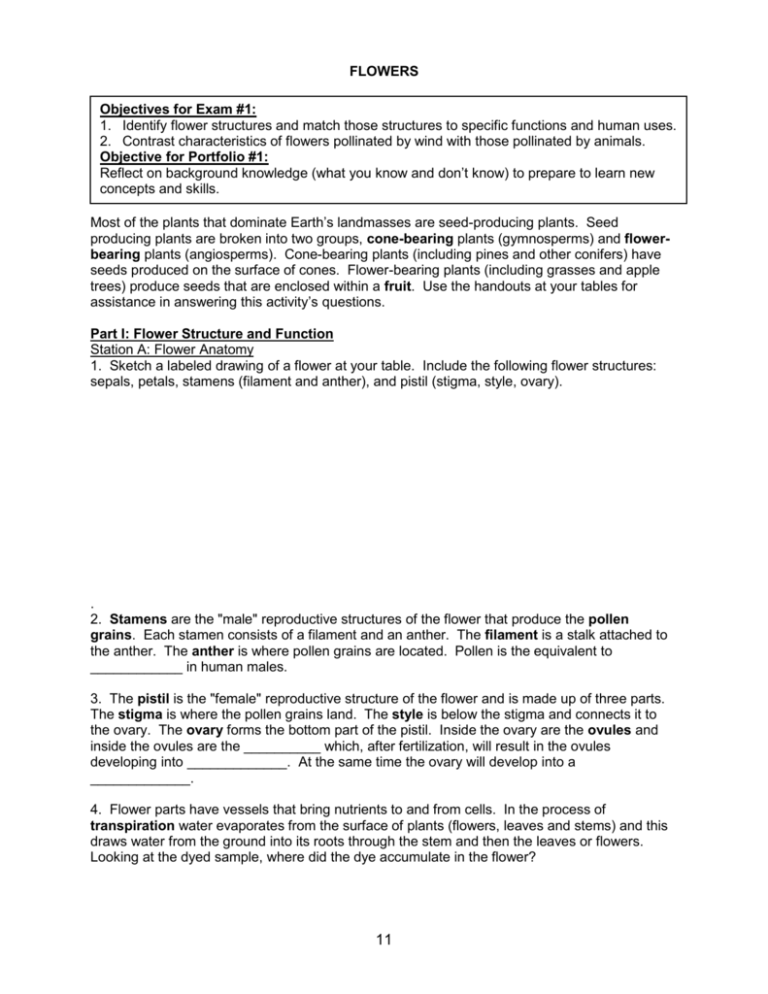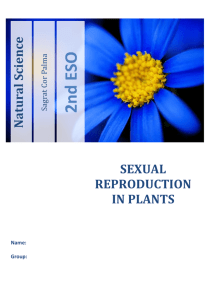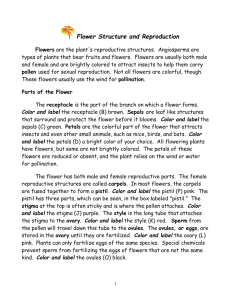Part I: Flower Structure and Function
advertisement

FLOWERS Objectives for Exam #1: 1. Identify flower structures and match those structures to specific functions and human uses. 2. Contrast characteristics of flowers pollinated by wind with those pollinated by animals. Objective for Portfolio #1: Reflect on background knowledge (what you know and don’t know) to prepare to learn new concepts and skills. Most of the plants that dominate Earth’s landmasses are seed-producing plants. Seed producing plants are broken into two groups, cone-bearing plants (gymnosperms) and flowerbearing plants (angiosperms). Cone-bearing plants (including pines and other conifers) have seeds produced on the surface of cones. Flower-bearing plants (including grasses and apple trees) produce seeds that are enclosed within a fruit. Use the handouts at your tables for assistance in answering this activity’s questions. Part I: Flower Structure and Function Station A: Flower Anatomy 1. Sketch a labeled drawing of a flower at your table. Include the following flower structures: sepals, petals, stamens (filament and anther), and pistil (stigma, style, ovary). . 2. Stamens are the "male" reproductive structures of the flower that produce the pollen grains. Each stamen consists of a filament and an anther. The filament is a stalk attached to the anther. The anther is where pollen grains are located. Pollen is the equivalent to ____________ in human males. 3. The pistil is the "female" reproductive structure of the flower and is made up of three parts. The stigma is where the pollen grains land. The style is below the stigma and connects it to the ovary. The ovary forms the bottom part of the pistil. Inside the ovary are the ovules and inside the ovules are the __________ which, after fertilization, will result in the ovules developing into _____________. At the same time the ovary will develop into a _____________. 4. Flower parts have vessels that bring nutrients to and from cells. In the process of transpiration water evaporates from the surface of plants (flowers, leaves and stems) and this draws water from the ground into its roots through the stem and then the leaves or flowers. Looking at the dyed sample, where did the dye accumulate in the flower? 11 Station B: Flowers and Pollinators 1. Most species of flowering plants sexually reproduce with the assistance of animals, the pollinators (primarily insects, birds, and bats), that carry pollen. Plants pollinated by pollinators typically expend less energy on pollen production than wind-pollinated plants. These plants have flowers with specific shapes, textures, colors, patterns, odors, and/or food rewards that can attract unique pollinators (or their prey). From the handout (textbook p. 2), fill in the flower type that attracts each of the following pollinators, and from the handouts and/or flowers at your table, fill in an example of a flower that attracts each type of pollinator. Pollinator Flower Characteristics Plant Example Bee Fly Butterfly Night-feeding Moth Bat Beetle Hummingbird 2. Moth-pollinated plants often have spurs or tubes the exact length of a certain moth’s proboscis (“tongue”). From the handout provided at your table, describe how researchers showed that flower spur length affects a flower’s reproductive success. 3. In some large, showy flowers, the “flower” as we think of it is actually an inflorescence, an arrangement of many flowers. For example, a sunflower is actually comprised of two different types of smaller flowers. From the textbook (p. 5), what is the advantage of the composite flower structure? Station C: Wind Pollination 1. Less than 20% of flowering plant species are wind-pollinated, instead of pollinated by animals. However, wind-pollinated plants include grasses and many trees. From the handout provided at your table, describe why these grasses and trees are significant to humans. 12 2. Many wind-pollinated plants, including corn, have different male and female flowers. In a corn plant, a cluster of male flowers is called a tassel. The male flowers produce ____________ which is carried by the wind to female flowers. Pollen falls onto the silks of female flowers, which develop into individual corn kernels. Typically the male and female flowers on a single plant mature at different times, to prevent self-pollination. Label the parts of a corn plant on the picture below. 3. Wind-pollinated plants produce large amounts of pollen, and some of the pollen makes it to another flower for successful pollination. Wind-pollinated flowers are typically green, small, odorless, and do not produce nectar, as they do not need to attract pollinators. Grasses have many small flowers making up a single inflorescence, often called a spikelet. Examine the grass flowers with a magnifying glass. Using the handouts provided as a reference, sketch and label a grass flower, including the pollen-producing anthers and the pollen-receiving stigma. Note that the anthers and stigma are exposed so pollen can be dispersed by wind. Station D: Floral Diversity 1. The scientific name of organisms contains the Genus and species names, with the Genus name capitalized, and both names italicized or underlined (like Coffea arabica for the coffee plant). This means that Capsicum annuum (bell pepper) is in the same ____________ as Capsicum chinense (chili pepper), but is a different ________________. The species name chinense was a mistake, chili peppers originated in the “New World,” not China. 2. Carl Linnaeus (1707-1778) observed that certain plants opened and closed their flowers at specific times of day. He proposed that a “flower clock” garden could be planted to indicate the time of day. Gardeners plant regional flower clocks around the world today. Considering that most flowers rely on animal pollinators for reproduction, what could be an advantage to a plant of flowering at a specific time of day that differs from the flowering time of other plants? 13 3. Flowers also open for different lengths of time. Cherry trees typically bloom for only a week, while some orchid species can bloom for months. From the materials provided at your table, what are the characteristics of flowers that live the longest? 4. Botanists (biologists who study plants) often work with preserved flower specimens that are dried, frozen, or stored in alcohol. Herbariums (collections of preserved plant specimens) typically consist of pages of dried plants that were prepared using specialized plant presses. You can also press thin flowers, leaves, stems and roots using a book. Place the sample between two sheets of blank paper amid the pages of a book. Weigh the book down and wait a few weeks. There are pressed flower specimens at your table. What is an advantage and a disadvantage of studying preserved flower specimens instead of relying on live specimens? Part II: Background Knowledge Survey (for Portfolio #1) Skill: Reflect on background knowledge (what you know and don’t know) to prepare to learn new concepts and skills. Assignment: This assignment has three parts. (1) Fill in the Pre-Assessment Survey form individually. Answer true (T), false (F), or don’t know (DK) for every question. It is fine if you do not know the correct answers; answer each question to the best of your current ability. (2) Check answers at the BI 101 website http://science.oregonstate.edu/bi10x/ (main page under “Portfolio Links”) and fill in the correct answers in the appropriate column. (3) Write a paragraph reflection on (A) where you learned the answers that you answered correctly on the survey, and (B) what you have learned as a result of completing the survey. If you did not know any of the information prior to the survey, do not remember the sources of information, or did not learn anything from the survey, include this information as well. The paragraph reflection can be written on the back of the survey or typed on a separate sheet of paper. Assessment: This assignment is worth 3.0 points. 1.0 point is for answering the survey questions and filling in the correct answers from the website, and 2.0 points are for the reflection paragraph (1.0 point for stating the source of what you knew on the survey, and 1.0 point for what you learned by completing the survey). Portfolio assignments represent your individual skills. Do not submit an assignment that is a duplication of any other individual’s assignment. 14 Background Knowledge Survey Include this page in Portfolio #1, along with reflection paragraph (Keep your other Flowers activity pages to study for the exam) # True, False, or Don’t Know Question 1 Coniferous trees have flowers that produce spores instead of seeds. 2 Nutrients (e.g. phosphorous, nitrogen, and calcium) and energy are cycled within ecosystems. 3 There are generally a greater number of different species in a Family than in a Phylum. 4 Symbiotic relationships typically benefit both participants. 5 6 Due to current climate change in the Northern hemisphere, deserts are converting to grasslands, and grasslands are converting to forests. Approximately 20% of the water on Earth’s surface is characterized as freshwater, with the other 80% classified as saltwater. 7 The calories we obtain from eating meat represent more solar energy than the calories we acquire from eating vegetables. 8 Due to the enforcement of the Clean Air Act, the United States is no longer a major producer of greenhouse gases (e.g. methane, carbon dioxide). 9 Approximately forty percent of mammal species are rodents, which includes mice and beavers. 10 Habitat alteration is currently the primary cause of species extinctions. 11 Most deserts are located at 45 degree North and South latitudes. 12 13 14 15 16 17 18 Centipedes and millipedes are classified as insects, but not as “bugs.” Larger land animals (reptiles, birds, mammals) have all been discovered and identified, although there are still many insect, bacterial, and aquatic species to find and identify. The primary nonliving reservoir of carbon is the sediment, and the primary nonliving reservoir of nitrogen is the atmosphere In marine ecosystems, humpback whales, blue whales, crabeater seals, fish, albatross, and penguins all eat krill. After fertilization, ovules develop into seeds, and ovaries develop into fruit. Ecology is defined as the study of how to reduce the use of resources through increased efficiency, reuse, recycling, and decreased demand. Tropical rainforests support a high diversity of life due to the presence of nutrient-rich soils. 19 As of 2001, the United States had reached zero population growth (ZPG). 20 Fungi, including the mushrooms we eat, are classified in Kingdom Plantae. 15 Correct Answer (from website) 16









